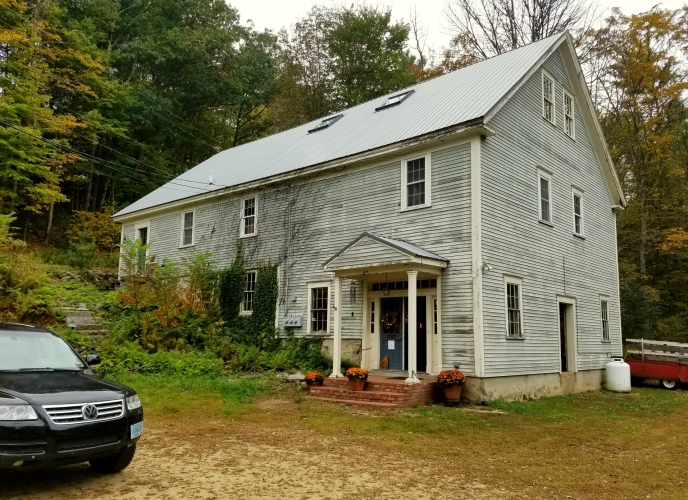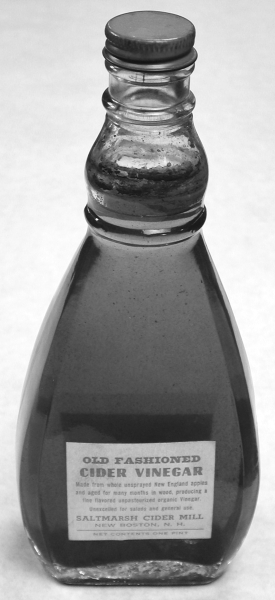New Boston Historical Society
New Boston, New Hampshire

The Cider Press
Inspiration For Art and Culture
by Bob Todd
December 2002
On a recent Friday evening, Bob Belanger, of "Cider Press" (the band) fame, enthusiastically showed off his unique home. The focus of his pride and enthusiasm was the rare antiquity in the cellar of the home on Francestown Road he and his wife Eileen have lived and worked in since 1974 — the Cider Mill. I was soon caught up in Bob's eloquent story. But, I did not anticipate my response to it and the great excitement that welled up in my heart. Many memory files, sealed since my adolescent and young adult years, were read into my consciousness, to the point of distraction from Bob's demonstration.
 That evening I walked through the heavy wooden doors, pushed to the side with considerable exertion.
These doors are at the street entrance to the Cider Mill ramped down from the pavement on Francestown Road to which it is very close.
Upon entering the wide aisle that extends the full length of the upper level of the old mill, presumably built by J.R. Whipple in the decade of 1880, I was greeted by Bob and Eileen.
I exclaimed, "Your front door is the largest I have ever seen". "Yup, probably is", Bob replied.
I spilled the first memory that came to my mind,
"I remember riding in my Dad's 1936 Ford dump truck as he backed it through this same doorway, down the aisle,
to the opposite end where I helped unload boxes of apples that Dad had hauled from a local orchard for Paul Saltmarsh."
Dad hauled a lot of apples for Paul while I was growing up and it was in this period that I was first intrigued by the old mill.
That evening I walked through the heavy wooden doors, pushed to the side with considerable exertion.
These doors are at the street entrance to the Cider Mill ramped down from the pavement on Francestown Road to which it is very close.
Upon entering the wide aisle that extends the full length of the upper level of the old mill, presumably built by J.R. Whipple in the decade of 1880, I was greeted by Bob and Eileen.
I exclaimed, "Your front door is the largest I have ever seen". "Yup, probably is", Bob replied.
I spilled the first memory that came to my mind,
"I remember riding in my Dad's 1936 Ford dump truck as he backed it through this same doorway, down the aisle,
to the opposite end where I helped unload boxes of apples that Dad had hauled from a local orchard for Paul Saltmarsh."
Dad hauled a lot of apples for Paul while I was growing up and it was in this period that I was first intrigued by the old mill.
Bob showed me the hole in the upper level floor where apples were dumped down a chute to the grinder attached to the superstructure of the cider press on the level below us. As I followed Bob down the stairway I could detect a faint smell of apple lingering in the cool humidity. I had to tell Bob the first thing I noticed on the stairway, "My feet aren't sticking to the stairs the way they used to when Paul Saltmarsh owned the place. Most anywhere in the press room I tried not to stand in one place too long - being uncertain that I would be able to lift my feet." "Yeah, Eileen and I had to really scrub and scrape this place to clean up the sticky floor," replied Bob.
Before my eyes, as I stood at the bottom of the stairs, was the old cider press that I remembered as a teenager. It was clean and beautifully painted red with gold scrolls decorating the linear wood parts, Eileen's artful skill obviously applied here. The metal parts of the apparatus are painted black. Bob exuberantly began a description of his equipment and a demonstration of the apparatus while I struggled to pay attention by suppressing old memories. He pointed out the seal on the face of the structure on which was stamped, Boomer and Boschert Press Co., Syracuse, N.Y. #1. According to Bob, the number signifies the model size and this is the smallest of 4 models. The platen (the wooden surface at the bottom of the press) is 48 inches square.
I hung on to Bob's description of how the press worked, reinforced by images in my mind of Paul Saltmarsh and his assistant, Charles "Mudworm" Murdough working right where we stood. "Look here Bob, the platen turns on this large round track to the loading position under the pommace grinder." Pommace is diced up apples. As he placed on the platen a square device comprised of wooden slats joined in a grid, he continued, "These press racks are put on the platen and a filter fabric is placed on it, Paul used burlap, I use polyethylene fabric. Then the grinder chute is opened and pommace from four or five bushels of apples is spread in a layer of uniform thickness on the filter which is then folded over the top of the pommace and another press rack added. This process is continued until the stack of racks and pumice layers are five high. Although Paul may have pressed a stack of eight pommace layers, I get more cider yield from the pommace by stacking only five", said Bob.
We looked at the picture of the press displayed on the wall, enlarged from the book, "About the Farm", published by J. R. Whipple to promote his farm, and we counted eight layers. This picture prompted a discussion about the history of the cider press.
 Bob recalled that the Whipple Company used it until about 1919 and Paul Saltmarsh operated it from 1936 until his sudden death in the middle of the pressing season in 1973.
I later found that Mr. Saltmarsh purchased the mill in 1944 so it is speculation that he rented the facility from Constance Fitzgerald, the former owner, from 1936 until 1944.
I wonder if the equipment languished from 1919 until 1936. I also wonder what destiny held the cider press off the list of items on the auction bill that were sold in 1920.
This auction liquidated all the farm equipment owned by the J.R. Whipple Company. The land was sold to real estate investors and is now in the title chains of many homes in the village.
Bob recalled that the Whipple Company used it until about 1919 and Paul Saltmarsh operated it from 1936 until his sudden death in the middle of the pressing season in 1973.
I later found that Mr. Saltmarsh purchased the mill in 1944 so it is speculation that he rented the facility from Constance Fitzgerald, the former owner, from 1936 until 1944.
I wonder if the equipment languished from 1919 until 1936. I also wonder what destiny held the cider press off the list of items on the auction bill that were sold in 1920.
This auction liquidated all the farm equipment owned by the J.R. Whipple Company. The land was sold to real estate investors and is now in the title chains of many homes in the village.
Bob drew me back into his explanation about the operation of the press. "Once the stack is ready the apparatus is turned on the round track to a position under the press mechanism comprised of gears and screws driven by an electric motor, a three horsepower induction start motor dating back to 1916, installed by the Whipple Company to replace the original gas engine." Then he turned on the motor and lowered the press to show how slow it went down. I was thrilled to again hear the slapping sound of the long belts and the rumble of long steel rods transmitting power from the motor to the press. He went on, "The cider runs onto the wooden base of the platen to the inlet of a pipe that carries the sweet liquid to a large wooden vat under the platen. From there the cider is pumped into barrels for storage, or into retail sized containers. I get about seventy gallons per pressing which is a yield of about three gallons per bushel of apples run through the press."
I asked Bob, "What do you do with the pommace that has been pressed", I asked? This question was cued by my memory of forking this firmly matted "stuff" into Dad's dump truck so many times. We took it home and dumped it beside the dairy barn entrance and Dad fed it to the cows. "Fred Byam comes and picks it up for hog feed, spent pommace is an excellent animal feed", replied Bob.
I commented, "I have not noticed much activity at the mill for several years." He replied, "We make a point of pressing cider at least one weekend per year, we call it our Annual Never Making Cider Anymore party. Roger Swain, formerly with WGBH's show, Victory Garden comes and we have a great time." I recalled the many enjoyable times that I had been to Bob and Eileen's to buy cider and gifts and the times I bought cider, apple syrup, apple jelly, and vinegar from amiable Paul Saltmarsh.
We did not go into the barrel room, a large window-less cellar behind the press room where the 55 gallon oak barrels were stored while the cider was allowed to ferment and turn to vinegar. I was content to recall the feeling of being in the room long ago and to remember the tickle in my nose brought on by the acidic-sour smell of vinegar. John Young, local orchardist and producer of apple products, told me that Paul would have over 200 barrels of vinegar in the cellar each year and that he could make vinegar in one year, although some say that the process takes up to three years. He went on to say that Paul was a pioneer in marketing organic foods and for many years he sold most of his product to "organic" outlets, this was from about 1960 until his death.
I am thankful to Bob and Eileen Belanger for offering an opportunity to experience the cider mill again and for the encouragement to feature this grand antique in my column. The attitude they share about their role in sustaining this significant part of the Whipple Farm legacy is a model for stewardship and promotion of cultural heritage. To my knowledge, the Belanger's cider press is the only remaining Whipple Farm equipment still functioning as it did 120 years ago.
Click here to return to the Cider Mill main page.
